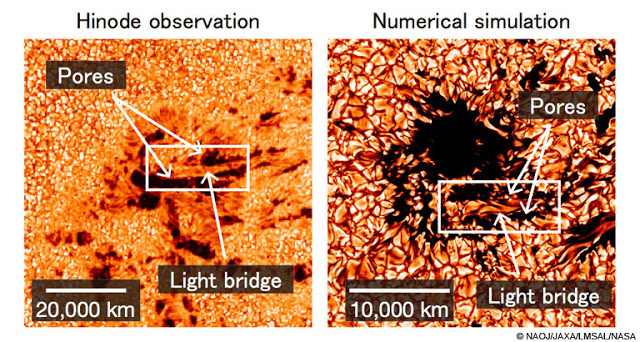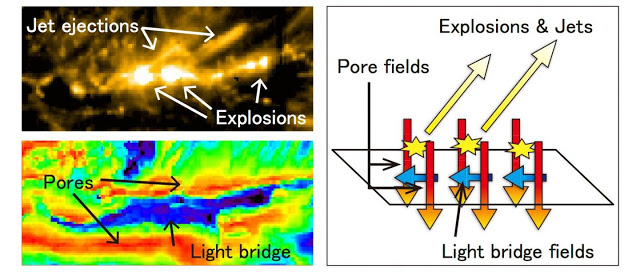| Online: | |
| Visits: | |
| Stories: |

| Story Views | |
| Now: | |
| Last Hour: | |
| Last 24 Hours: | |
| Total: | |
Mechanism of Explosions and Plasma Jets Associated With Sunspot Formation Revealed
Field lines extend from the solar interior and appear at the solar surface. The horizontal fields of the bridge (sky-blue) are pressed between the vertical fields of the pores (red). The magnetic flux splits into two parts, which appear as two pores at the surface. Weakly-magnetized plasma is sandwiched between the two flux bundles.
Credit: NAOJ/LMSAL/NASA
(Left) Hinode observation of a developing sunspot is shown. An elongated bright feature called a ‘light bridge’ appears between the merging pores (darkest parts). (Right) Computer simulation of sunspot formation. A light bridge resembling the one observed is formed between the pores.
Credit: NAOJ/JAXA/LMSAL/NASA
The intense magnetic fields of sunspots energize the Sun’s atmosphere, often triggering solar flares and ejections that have a direct impact on the space environment around the Earth. How sunspots are born, how they evolve, and how they impact space weather are questions central to our understanding of the Sun and the magnetic relation between the Sun and the Earth. Space missions such as Hinode, the Solar Dynamics Observatory (SDO) and the Interface Region Imaging Spectrograph (IRIS) allow scientists to witness the birth of sunspots in unprecedented detail. These combined observations reveal how magnetic field lines in the Sun’s interior emerge onto the surface. First, the magnetic fields appear as ‘small’ bundles the size of cities and states. Sometimes, when two neighboring ‘proto-spots’ (known as pores) approach each other, they squeeze the intervening weakly magnetized plasma into an elongated structure called a light bridge. As the coalescence progresses, the light bridges are eventually squeezed out of existence and fully-fledged sunspots are formed. The power struggles of the magnetic field during this amalgamation process triggers repeated episodes of plasma jets and explosions.
Upper left) NASA/IRIS observation of the atmosphere above the light bridge is shown. Explosions and jet ejections are caused by a mechanism called ‘magnetic reconnection.’ (Lower left) Hinode observation of magnetic fields on the solar surface. Color indicates the inclination of the magnetic fields. The pores have vertical magnetic fields (red), while the bridge has horizontal fields (blue). (Right) Illustration summarizing the observational results. Magnetic reconnection between the bridge’s horizontal fields and the pores’ vertical fields produces explosions and jet ejections.
Credit: NAOJ/JAXA/NASA
Dr. Toriumi and his colleagues tracked the formation of a sunspot in unprecedented detail using data from Japan’s Hinode satellite as well as data from NASA’s Solar Dynamics Observatory and the Interface Region Imaging Spectrograph. By combining this data with a detailed computer model of sunspot formation performed on the Pleiades supercomputer at NASA Ames, their work explains how the pores merge, how sunspots are created, and why explosions and jets occur between the merging pores.
First, they analyzed the satellite observation data and determined the detailed magnetic structures of the pores and bridge as well as the mechanism for the explosions and jet ejections. High-resolution observations of the surface magnetic fields by Hinode revealed that the two merging pores have strong, vertical magnetic fields while the sandwiched light bridge harbors weak, horizontal fields. In addition, IRIS observations of the atmosphere above the light bridge showed that explosions and jet ejections take place repeatedly and intermittently as a result of magnetic reconnection. This means that the horizontal fields of the bridge repeatedly snap and establish new connections with the vertical fields of the surrounding pores. This results in sudden, repetitive bursts of activity (explosions and jet ejections).
What drives the formation of the light bridge and the misalignment between adjacent magnetic fields? The team answered this question with the help of NASA’s Pleiades supercomputer. Their computer model showed how streams of magnetism in the solar interior bursts onto the surface of the Sun. The emerging magnetic flux first appears as small bundles, but self-organizes into larger conglomerates to eventually form a sunspot. The model reproduces the light bridge and pores found in the observations and offers the following explanation. As two walls of magnetic flux approach each other during sunspot formation, plasma with weaker magnetic fields is sandwiched between the walls. As this trapped material is squeezed, it appears as a light bridge at the surface. The magnetic field of this trapped plasma is misaligned relative to the neighboring strong fields, which results in magnetic reconnection causing repeated eruptions and plasma jets.
This research reveals that subsurface motions in the Sun are the ultimate driving force of bursty activity in the Sun’s atmosphere. The solar interior serves as the reservoir of energy that gives birth to sunspots, which structure the magnetic field of the Sun’s corona and determine how the Sun affects the Earth magnetically. The similarities between observations and numerical simulations suggest that we are beginning to understand the fundamental processes operating in the Sun’s interior and atmosphere. These physical principles, which dictate the evolution of magnetic plasmas, also operate in the heliosphere, in other astrophysical objects, and in fusion devices in the laboratory. Missions including Hinode, SDO, and IRIS observe the Sun, turning it into a natural laboratory for studying plasma physics.
Solar flares: Massive explosions which occur on the solar surface. These are the largest explosions in the Solar System today. The intensities of electromagnetic waves of various wavelengths increase suddenly, sometimes ejecting high-speed plasma clouds into space. Therefore, the sunspots may affect the Earth by producing exceedingly vigorous flares.
Light bridges: Bright, elongated structures that divide sunspot umbrae (the darkest parts in the spot centers). Light bridges are seen in the developing and decaying stages of the sunspot life cycle. This research focuses on the bridges that appear during the merging of pores to form sunspots.
Magnetic reconnection: The physical process where magnetic fields with different orientations approach and reconnect to each other. This process converts magnetic energy to kinetic and thermal energy. This is thought to be the energy-release mechanism in solar flares.
Masaaki Hiramatsu
Source:





